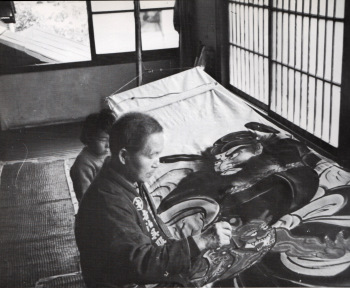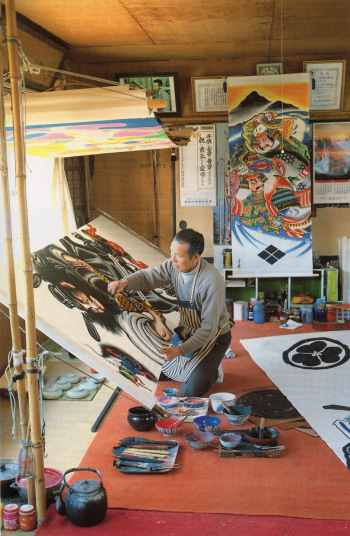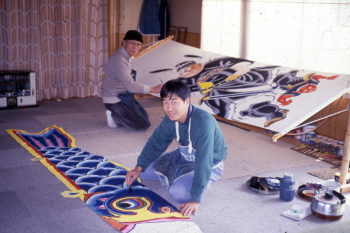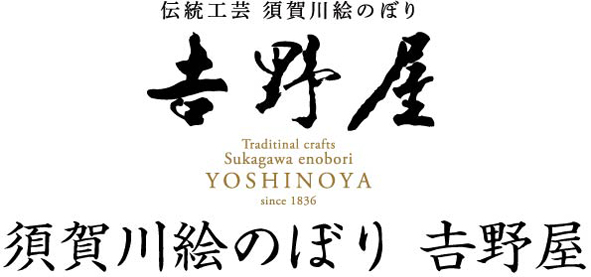当初絵のぼりは、五月の端午の節句の時期だけ副業として営まれたので「節気物(せっきもの)」と呼ばれていました。元々吉野屋は呉服屋でしたが、初代 大野松岳(善吉)が絵のぼりを描き始め、二代目 治兵衛から三代目 一峰(吉次郎)の代にほぼ今の絵のぼりの基礎が作られた、と言われています。それは今から約100年前のことです。その後、昭和36年頃より関東地方の型刷りのぼりが出回った影響で、当時市内に七軒あった絵のぼり制作者が次々と転業し、吉野屋が唯一の工房となってしまいました。しかし、吉野屋は四代目 忠助の苦労の甲斐があって戦前戦後の物資の貧しい時にも転業することなく、五代目 青峰(恒雄)へと受け継がれました。青峰は、色やデザインに近代感覚を盛り込んだ室内用(掛け軸型)絵のぼりを開発し、伝統的工芸品産業功労賞など数々の表彰を浴しました。
現在は六代目 青峯(修司)が、手描き染めの伝統を受け継ぎながら端午の節句ばかりでなく、記念品や室内装飾として用いられる額や室内用絵のぼりの開発に努めています。
The Story of Yoshinoya
Enobori was a seasonal work called “Sekkimono” during the festival in May run by fabric shops or dye houses, and Yoshinoya was originally a fabric shop. The founder Shogaku Ohno (Real name: Zenkichi Ohno) started the business, but the current foundation of Enobori was established sometime between the second generation owner, Jihee Ohno and the third generation owner, Ippo Ohno (Real name: Kichijiro Ohno). This was nearly one hundred years ago. The fourth generation owner, Chusuke Ohno continued the family business, however, different kinds of Enobori paintings were developed from the Kanto region (Tokyo and the surrounding areas) around 1961 and became more popular. As a result, seven Enobori painting shops across Sukagawa city had to close down and Yoshinoya was the only shop that survived. Despite the difficult challenges, the fourth-generation owner, Chusuke worked very hard before and after the war to ensure that the family tradition was passed on to the next generation. The fifth generation owner, Seiho Ohno (Real name: Tsuneo Ohno) developed a new modern indoor coloured Enobori and this innovation revived the business, making it successful. Today, Enobori is recognised as one of Japan’s traditional crafts and has received many awards such as the Traditional Crafts Industry Achievement Award. Currently, the sixth generation owner, Seiho Ohno (Real name: Shuji Ohno) is running the business. He proudly carries on the family’s traditional methods while expanding the art to gifts and indoor decorations.

四代目 大野忠助:1830〜1868年の天保〜慶應時代、田騏から初代大野松岳へ継がれた当時の吉野屋は、近郷にその名が知られ、絵のぼりが町の名物となり、2代目治兵衛、3代目一峰、4代目忠助へと継承される。
Chusuke Ohno (Fourth generation owner): From the Tenpo period to the Keio period (1830−1868), Shogaku Ohno took over Yoshinoya from Denki and Enobori became known as a famous product in Sukagawa. Yoshinoya continued to be managed by the Ohno family, from Jihee (Second generation owner) to Ippo (Third generation owner) to Chusuke.

五代目 大野青峰(恒雄):色彩やデザインに新感覚を盛り込み、掛け軸型の室内用絵のぼりを開発。1985年、須賀川市日中友好協会芸術文化交流訪中団として訪中。天津市南開大学東方芸術学部主任教授范曽画伯から筆法奥義を伝授。
Seiho Ohno(Fifth generation owner): Seiho developed a new modern indoor coloured Enobori. In 1985, he visited China as a member of the Japan-China Friendship Association for Art and Cultural Exchange from Sukagawa. During the trip, he met Professor Hanson, a master painter of Oriental Art from Nankai University and learnt the Chinese painting techniques which Seiho incorporated into his artwork.

東方芸術文化交流:1985年、須賀川市日中友好協会芸術文化交流訪中団の一員として五代目 大野青峰が訪中。天津市南開大学の東方芸術学部主任教授范曽画伯から、鍾馗(しょうき)筆法の奥義を直接伝授される。
Tohoku Art and Cultural Exchange: The photo was taken in 1985 when Seiho visited China as a member of the Japan-China Friendship Association. He incorporated the painting technique he learnt from Professor Hanson, from Nankai University, Oriental Art faculty.

